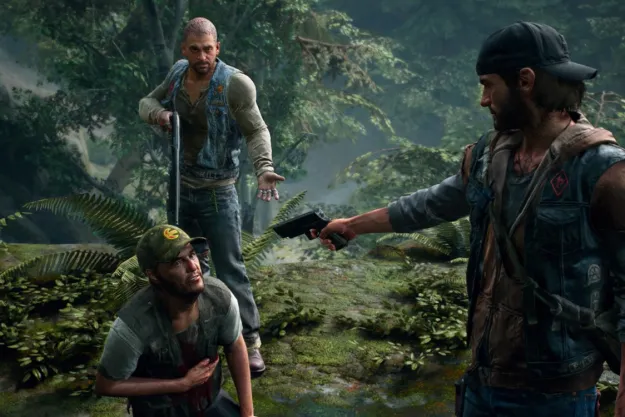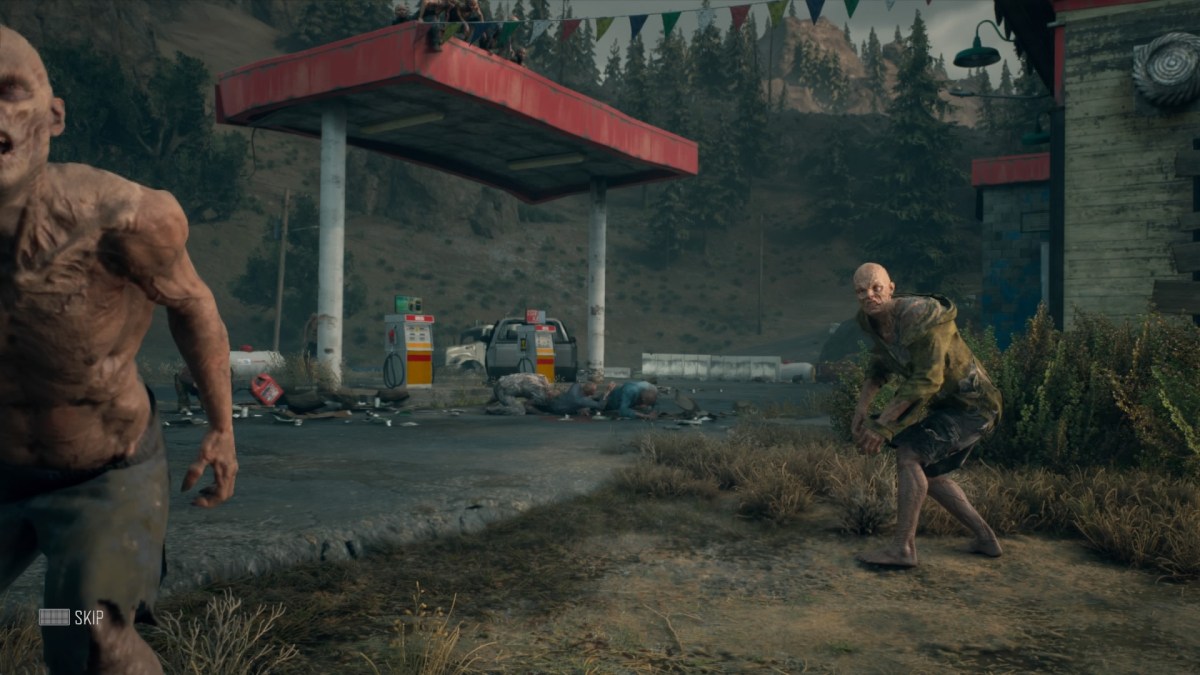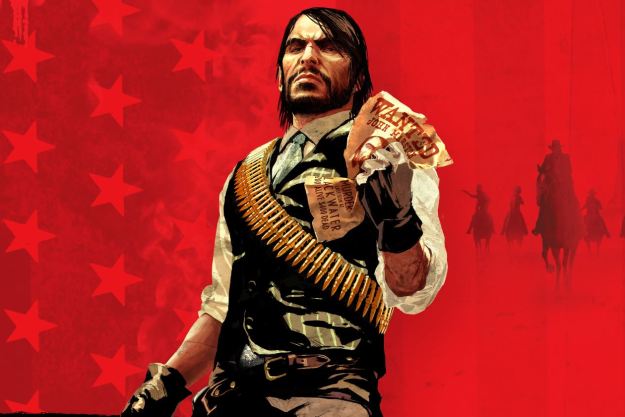
“Days Gone is a generic open world zombie fest riddled with tedium and performance issues.”
- Good dialogue, acting performances
- Spacious open world
- Loads of performance issues
- Needless survival mechanics
- Poor stealth and gunplay
While you technically haven’t played it, you have played Days Gone before. It’s SIE Bend Studio’s first console game since 2004 and it has many of the same trappings of modern open world games — tired, repetitive missions, a vague and predictable post-apocalyptic story, and tedious survival mechanics thrown in for good measure.
It’s a confounding experience. Not only does it refrain from bringing any new ideas to the table, but the execution of its well-trodden features and mechanics is often below average. Gunplay is weak and imprecise, melee combat is dull, and stealth is unbalanced and finicky. Even the fast travel system is annoyingly tied to your motorcycle’s fuel and whether or not you’ve cleared out infestations of zombies — sorry, “Freakers” — in the area. To make matters worse, performance on the base PS4 is consistently bad. Framerate frequently drops, creating jagged visuals and stuttering delays.
I spent a total of 36 hours — 1.5 days gone — inside post-apocalyptic Oregon, and I’m most struck by the blandness of it all. Hour after hour sifted away uneventfully, and when it was finally over, I mostly felt numb, unmoved by its many parts that never coalesce to create something more than a familiar, shoddy void.
Genre clash
About two years before the events of Days Gone, a virus mutated a significant portion of the population into cannibalistic monsters known as Freakers. The world quickly devolved into chaos, and many lives were lost beyond just the infected, including Deacon St. John’s wife, Sarah. Days Gone picks up roughly two years after the onset of the apocalypse. Deacon and his best buddy Boozeman (Deacon’s words, not mine), live the drifter life, working odd jobs for the various encampments in the area, just trying to survive.

At first blush, Days Gone appears to be a traditional third person action game. But in practice, it’s more of a stealth game laced with action sequences. Freakers move quickly and come in a few varieties; they roam the roads, dwell in buildings, and lurk in the dense Pacific Northwest forestry. They are alerted by sound even more so than sight. Very quickly it’s shown that the best way to manage the Freaker population, and even the human enemy groups, is through careful consideration and cautious movements.
Up close, Days Gone turns into a hack and slash game with repetitive animations.
Though it is interesting to have a truly open world game indebted to stealth, cracks in the foundation are quickly exposed. The stealth detection, for starters, simply isn’t very good. Sometimes you’re discovered when the on screen detector shows you as hidden and silent, and other times you can stomp around like an elephant unseen by both humans and Freakers.
Further contributing to Days Gone’s disappointing mechanics is the melee combat itself. Deacon’s always on-hand boot knife is pitifully weak, but also incredibly inconsistent. Sometimes I killed enemies with three or four slashes and other times it took closer to ten. Melee weapons you find such as axes, machetes, and baseball bats, do more damage, but they also degrade quickly. Up close, Days Gone turns into a hack and slash game with repetitive animations. Killing blow animations are cool, but overall it gets stale too quickly.
Long range combat with guns, from pistols to shotguns to crossbows to automatic rifles, is available from the jump, too. But this is one of those zombie games that has annoying rules when it comes to bullets. Shoot a zombie or human in the head, and they’ll drop instantly. Shoot them in the chest and you could unload six, seven, even eight shots before they fall.
Most of the weapons feel rather toy-like and imprecise as well. Ammunition, especially early on, is fairly limited. It has a Resident Evil 4 vibe in this sense. Ammo isn’t necessarily rare, but it’s fairly easy to run out in the first half of the game if you aren’t getting headshots. Human enemies necessitate more firepower simply because they routinely have guns as well, but they aren’t particularly smart, making battles with groups of Rippers or Marauders far too predictable.
Days Gone’s balancing act between making Deacon St. John a hybrid stealthy assassin/action hero never quite gels. All throughout the adventure, you’re encouraged to seek out stealth takedowns, to conserve ammo for boss-type enemies and run ins with other gun-toting humans. The mission structure, a mix of dedicated stealth missions, fetch quests, and eliminate “x” number of enemies, rarely dabbles with the unexpected. This is essentially an all you can eat menu of open world mission types you’ve played plenty of times before.
This is essentially an all you can eat menu of open world mission types you’ve played plenty of times before.
And then, after spending so much time playing cautiously, you have to confront a central foe that’s talked about from the very beginning: hordes. Hordes are packs of hundreds of Freakers. Taking down an entire horde has absolutely nothing to do with stealth. In missions, when hordes have boss meters, the stealth is actually kind of broken. Even if you sneak up on a horde feasting in a pit together, it’s hard to actually get the jump on them.
The horde-specific (giant) molotov doesn’t appear to deal damage to the boss meter health bar until they are alerted to your presence. On numerous occasions, I seemingly burned through a third of the horde, only to see little or no damage dealt to the meter. Additionally, the giant molotov is designed to take out a bunch of the Freakers as they squeeze through a tight space. But it simply doesn’t work as advertised as the flames go out long before it can do serious damage to the group.
It might be telling that the only time I was offered to skip a gameplay section in Days Gone was when I was up against a horde in a main mission, and that’s likely because once you’re surrounded, you’re as good as dead. Optional horde encounters fare a bit better, but there’s still an issue. Taking down hordes, which have been shown in trailers, isn’t fun. You have to alternate between shooting, throwing explosives, and running away from the pack. Or you can find a high vantage point where they sometimes can’t reach you. Downing hordes is all about having enough (and the right type of) firepower, not skill or technique.
Open world tedium
Much of your time in Days Gone, like many open world games, is spent traveling to the next objective. As a former bike gang member, Deacon has a trusty motorcycle. Actually, everyone in Days Gone gets around on motorcycles, despite plenty of abandoned cars to be found on the roads.
Perhaps in an effort to up the survival elements of Days Gone, your bike has to be refueled and maintained. At first, this seems like a novel mechanic. Rarely do games care about such matters of realism. But here, your bike runs out of fuel and takes damage to the point of needing engine maintenance. This happens quite often — too often. Deacon’s bike gets criminally low mileage and moves at the pace of a moped before being upgraded, which can’t be done for at least a few hours. On top of that, it takes damage easily. Your bike can eventually be quite impressive, but the work it takes to get there doesn’t feel rewarding.

All of this would be fine if there seemed to be a good reason behind it, but running out of gas or needing to find scrap to repair the engine never feels like a dire situation. Instead, it’s an annoyance. The sprawling, forested region of Oregon is Freaker-infested, but there’s never more than a handful within eyeshot outside of hordes and inside mission areas. Needing to manually refuel doesn’t raise the stakes, it only delays progress, pushing back the next meaningful moment.
Even fast travel is connected to fuel, meaning that you cannot get to a fast travel spot in a hurry without the proper amount of fuel. Again, this is theoretically supposed to raise the stakes, but the survival elements simply aren’t there. This is exacerbated by the fact fast travel is limited by Freaker nests, giant grotesque bird nests in walls where a few Freakers live. If the nests nearby haven’t been destroyed, you’re locked from fast traveling. While the number of nests in an area pops up on screen, the area itself isn’t clearly defined, so you’ll likely wind up doubling back in your search.
The dialogue is well written and acted, but the arc follows a predictable trajectory.
Adding to the perceived survival elements is, of course, crafting. It’s a minimalistic system comprised of around a dozen key items found in buildings, abandoned cars, and throughout wildlife. Components combine to create medicine cocktails, molotovs, pipe bombs, and traps for Freakers. However, if you take the time to search buildings and mission areas, you’ll rarely run out of required items, which is nice, but like the bike mechanics, it makes crafting feel rather pointless.
The survival aspects are shoehorned in for authenticity. This is a post-apocalyptic world, after all. Things aren’t supposed to come easy. But the crafting and resource management fall into the category of busy work, simply because the open world frequently chips away at the stakes. Scouring abandoned buildings for resources is dull, not risky.
Stealth is a huge factor in missions, but it has little bearing on the massive stretches of time spent exploring the rich, but ultimately hollow world. It’s only truly dangerous in mission and objective areas. So everything Days Gone leans into thematically gets washed away in the tedium that exists in the vast stretches between the perilous moments.
Even the setup, with two men living alone in the post-apocalypse, sets up Days Gone like a survival game. But it mostly doesn’t feel like one, with the exception of certain missions. The open world hinders the survival elements while the story itself revolves around them, and although the dialogue is well written and acted, the arc follows a predictable, if slightly long winded, trajectory. The cutscenes are well shot and plentiful, but the story that unfolds is hurt by the long stretches of tedium in between the pivotal moments.
Frames gone
Even if Days Gone had excellent mechanics, engaging missions, and a story that kept you guessing, it would still have a big problem: performance. Though I didn’t get to test it on a PS4 Pro, Days Gone has persistent problems on the base PS4. From combat and how Deacon walks to the way he gets on and off his bike, everything feels a bit janky. Textures routinely clip into another, and I experienced a handful of crashes and about a dozen freezes that lasted more than a couple seconds.
The crashes and freezes, spanning across 36 hours of play, are forgivable in my opinion. But the framerate is a constant problem. It’s not an exaggeration to say that every minute spent playing Days Gone resulted in numerous framerate drops. This happens frequently when riding across the open road, in combat, and even when just a single enemy or small building comes on screen. I’m not a framerate stickler by any means, but these drops are very noticeable. The screen stutters multiple times before returning to normal before starting up again soon after. It’s never-ending and unpredictable as to what causes it. The only predictable aspect of these performance issues is that they happen, a lot.
Even after multiple patches, Days Gone has the same issues. As of now, the performance alone may be hard to deal with for some players. Occasional framerate drops can be forgiven in big budget, ambitious games like Days Gone, but these issues aren’t intermittent. They are, right now, a core feature.
DT Gameplay
Our Take
Days Gone may have excellent dialogue and enjoyable cutscenes but it’s obvious that its gameplay didn’t receive that same level of refinement. It fashions itself as a stealth game, but the stealth mechanics are sometimes unpredictable and the melee combat grows stale quickly. Its pivotal moments turn its hero into an action star, but gunplay is underwhelming and lacks any real thrill. Though it places you in a post-apocalyptic setting, the survival mechanics do nothing more than add monotony without ever raising the stakes. Constant framerate drops and stuttering significantly hurts the experience on the base PS4. Sadly, Days Gone is the first real clunker of a PS4 exclusive.
Is there a better alternative?
Yes, there are tons of better open world options, including the recent Division 2 and Far Cry: New Dawn. For great open world PS4 exclusives, look no further than recent years: God of War, Marvel’s Spider-Man, and Horizon Zero Dawn.
How long will it last?
It took me 36 hours to complete the campaign and a bunch of side missions.
Should you buy it?
No, there are plenty of better open world games out there than Days Gone.
Editors' Recommendations
- Fallout 4 is finally getting free Xbox Series X and PS5 upgrades
- PS4 vs. PS5: which console should you buy in 2024?
- The best video game remakes of all time
- You only have one week left to share PlayStation clips and screenshots to X
- Best PlayStation Plus Deals: Save on Essential, Plus and Premium






